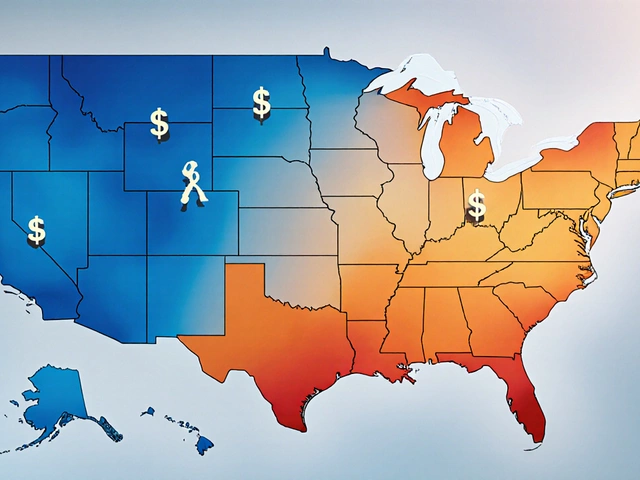The idea of getting prescriptions without visiting a doctor's office might sound like a modern marvel, but it’s rooted in practicality and technology-driven change. With the click of a button, many now find their health doesn't have to wait for an appointment, breaking the traditional chains of time and distance in healthcare.
Yet, this convenience begs a few questions: How safe is it? What safeguards are in place to ensure correct medication without the need for face-to-face doctor consultations? From regulations ensuring the legitimacy of online pharmacies to understanding the process—this landscape is as intriguing as it is beneficial.
Diving into this topic demands exploration of these crucial aspects, so potential users can embrace this new-age medicine with both awareness and a sense of security.
- Understanding Online Pharmacy Services
- The Process of Getting Prescriptions Online
- Benefits and Risks of Online Prescriptions
- Regulatory Aspects and Safety Concerns
- Comparing Telemedicine with Traditional Visits
- Tips for Safe Online Prescription Use
Understanding Online Pharmacy Services
The concept of online pharmacy services has revolutionized how individuals access prescription medications. Unlike traditional brick-and-mortar pharmacies, online pharmacies offer the convenience of shopping for medicines in the comfort of one's home. This service has increasingly become popular, particularly among those with mobility issues or those living in remote areas where a pharmacy isn't around the corner. Imagine a world where a few clicks can alleviate the worry of running out of essential medication.
These services operate by connecting patients with licensed healthcare professionals, enabling them to access prescription online through digital consultations. Such a method often requires users to fill out medical questionnaires that detail their health conditions and history, which are then reviewed by a healthcare provider. If deemed appropriate, the provider can issue a prescription that the online pharmacy will fulfill. The U.S. Federal Trade Commission emphasizes the importance of using legitimate online pharmacies as they are safe and reliable.
Online pharmacies may operate via their own platforms or through partnerships with telemedicine services. For instance, companies like Medly and GoodRx have expanded their reach by integrating digital channels for consultations. The unique selling point here is accessibility without the protracted waiting times that sometimes accompany traditional medical appointments. The efficiency of this system provides not only medications but also consultative advice, aligning with user demands for quicker, more efficient healthcare solutions.
However, while the advantages are noteworthy, vigilance from consumers is essential. The FDA warns of the presence of rogue online pharmacies that operate without proper licensing, a potential risk for users susceptible to purchasing counterfeit or unsafe medications. It’s crucial to verify URLs and look for certification logos, such as the Verified Internet Pharmacy Practice Sites (VIPPS) seal, which signals compliance with licensing regulations.
In a
report from the American Medical Association, it's highlighted, "The wave of online pharmacies represents a paradigm shift in how healthcare is delivered, offering benefits only attainable in a digital age. However, regulatory oversight must keep pace to safeguard public health."This shift indeed underscores the integration of technology in enhancing patient convenience and accessibility, marking a pivotal moment in healthcare evolution.
A notable statistic is the increasing trust in these services with surveys showing a 60% rise in subscriptions to online pharmacies post-pandemic, reflecting shifts in consumer behavior towards digital health solutions.
The Process of Getting Prescriptions Online
In the digital age, the steady rise of online pharmacy services has made obtaining prescriptions faster and remarkably more accessible. As the world leans into virtual solutions for everyday needs, healthcare isn't left behind. The process starts with choosing a reliable platform — a critical step, as it sets the stage for a safe experience. From well-known telemedicine providers to online marketplaces vetted for health services, numerous avenues offer connections to licensed medical professionals.
After selecting a platform, individuals typically need to create an account, a step that ensures privacy and adheres to medical record maintenance as per regulatory norms. Once registered, a health assessment usually follows, comprising detailed questionnaires about symptoms, medical history, and current health concerns. This information is crucial for doctors conducting online evaluations, offering insights that replace those gathered in person.
The breadth of conditions that can be assessed online is expanding. Online doctors often handle ailments commonly seen in primary care settings such as allergies, skin conditions, and even chronic disease management. Depending on the complaint and the platform, users might enter real-time chat windows with physicians, receive phone calls, or engage in video consultations to expound upon the details described in the questionnaire. This step is integral to forming a holistic picture of the patient’s health.
"The convenience of getting prescriptions online is undeniable, but users must ensure they consult credible sources," advises Dr. Rebecca Naroth, a telemedicine advocate. "Verifying the credentials and reviews of these services can help safeguard their health."
Once the consultation is complete, doctors generate an online prescription if deemed appropriate. Here, technology yet again plays a crucial role — these prescriptions are relayed electronically either directly to the patient's chosen pharmacy or sent through secure messaging to the patient. Efficient and time-saving, this means patients don't have to physically travel or wait unnecessarily long for medication.
Despite the ease, patients must be cautious and verify the authenticity of the platforms they use. It’s advisable to use services approved and recognized by health departments and consult lists of verified pharmacies. This ensures that the medication received is regulated and safe. As an innovation, it’s a process that seamlessly integrates technology into healthcare, creating a paradigm where time and accessibility barriers are diminished, giving way to an era where healthcare support can be reached with the same ease as ordering dinner.

Benefits and Risks of Online Prescriptions
The advent of the online pharmacy has transformed how many individuals manage their healthcare needs, with both significant benefits and potential downsides. On the brighter side, the convenience cannot be overstated. Imagine being able to acquire a necessary prescription online without the lengthy wait for a physician's appointment. This is particularly beneficial for those living in remote areas or for individuals with mobility challenges. Not only does this ease of access save considerable time, but it also provides immediate relief when medications are reordered seamlessly from the comfort of one's home.
Yet, as with most conveniences in the digital age, there are associated risks. The lack of a physical examination might lead to inaccurate prescriptions if thorough telemedicine consultations are not conducted. Mistakes in diagnosis or medication suitability can contribute to adverse effects, which may have been avoided with in-person evaluations. According to a study published in Health Affairs, without adequate regulation, the discrepancy in care quality between in-person and online consultations can widen the gap of trust between patients and healthcare providers.
"The challenge with online prescriptions lies not just in the efficacy of medication delivered, but in understanding the nuances of patient interaction that a screen may obfuscate," explains a veteran healthcare analyst in the Journal of Telemedicine and e-Health.
Privacy and data security represent another crucial concern. Online transactions necessitate the sharing of sensitive health information, and without stringent security measures, this data may be vulnerable to breaches. Several high-profile cases have highlighted such incidents, prompting a re-evaluation of how well online pharmacies are set up to protect user information. On the flip side, established and reputable platforms invest heavily in cybersecurity measures, providing a safer space for users. To mitigate these concerns, it's essential to verify if the online pharmacy is certified by authorities such as the National Association of Boards of Pharmacy.
The allure of cost savings should also be considered. Many online pharmacies thrive on lower overhead costs and are thus able to pass on savings to their consumers. They frequently offer competitive pricing compared to brick-and-mortar pharmacies, and occasional promotional discounts can make essential medications more affordable. However, the flipside sees consumers sometimes falling prey to fraudulent sites that offer 'too-good-to-be-true' prices, luring them into unsafe purchases. To stay safe, one should ensure any online pharmacy they engage with requires a valid prescription from a licensed physician before dispensing medications.
Lastly, the realm of telemedicine that encompasses online prescriptions is still a developing field, with regulations struggling to keep pace with technological advancements. While regions within the United States follow certain standardized guidelines, international laws can vary dramatically, potentially exposing patients to differing levels of care quality. The need for robust international standards has perhaps never been more important as we continue to navigate these digital healthcare frontiers. With these dimensions in mind, making informed choices about using online prescriptions is crucial to availing their benefits while minimizing inherent risks.
Regulatory Aspects and Safety Concerns
Navigating the world of online pharmacy services demands a thorough understanding of its regulatory framework to ensure both safety and legitimacy. The burgeoning field of digital prescriptions stands under the safety net woven by various governmental and international health authorities to protect consumers. In the United States, the Food and Drug Administration (FDA) alongside the Federal Trade Commission (FTC) plays a pivotal role in monitoring these services. They ensure that online pharmacies comply with extensive regulatory standards to safeguard public health and privacy. Such regulations are crucial, given that the virtual nature of online prescriptions can sometimes obscure clear oversight and accountability.
One significant concern is the prevalence of illegal pharmacies, which may operate without proper accreditation or dispense unauthorized medications. To combat this, the National Association of Boards of Pharmacy (NABP) has developed the Verified Internet Pharmacy Practice Sites™ (VIPPS) program, a verification meant to guide consumers towards safe and regulated services. By ensuring that a pharmacy has the VIPPS seal, patients can confirm the pharmacy is adhering to the rigorous standards of practice required to distribute medications responsibly.
According to a report by the NABP, over 95% of online pharmacies violate state or federal laws, underlining the risk consumers face in this quickly expanding market.
Beyond regulatory oversight, privacy remains at the forefront of consumer health concerns. The Health Insurance Portability and Accountability Act (HIPAA) governs how online pharmacies handle personal health information, mandating strict confidentiality and data protection measures. Despite these regulations, it is still crucial for users to remain vigilant about where they share their personal and medical information online. This vigilance is requisite as the lines between convenience and vulnerability often blur in the fast-paced digital world.
Consumers should also be aware of potential security breaches in digital platforms. As technology advances, so do the methods employed by cybercriminals. Pharmacies must implement robust cybersecurity measures to safeguard sensitive information such as prescription records and payment details. Look for platforms that use advanced encryption technologies and offer additional means of verifying customer identities to minimize these risks. This responsibility is shared between providers, regulators, and consumers to ensure a secure experience.
While the benefits of attaining a prescription online are numerous, the potential risks magnify the necessity of informed consumer participation. Engaging with digital healthcare should be done with clear awareness of the pharmacy's regulatory status and adherence to legal and safety requirements. By understanding and verifying that online pharmacies are properly monitored, individuals can make safer choices that still take advantage of the convenience offered by modern technology.

Comparing Telemedicine with Traditional Visits
The evolution of healthcare through telemedicine is a testament to technology's role in modern medicine. Comparing telemedicine with traditional medical visits reveals a blend of convenience and necessity that reshapes how patients interact with their healthcare providers. Telemedicine offers immense flexibility, especially for those living in remote areas or facing mobility challenges. This accessibility means that individuals no longer need to spend hours traveling or sitting in a waiting room for a brief consultation. They can connect with specialists regardless of geographical limitations, ensuring timely medical advice that could be critical.
In contrast, traditional visits provide a tangible experience—a chance for doctors to physically examine patients, which can be a significant factor in diagnosis. The tactile aspect of in-person consultations can often lead to more immediate follow-up tests or treatments. Many patients find reassurance in face-to-face interactions, perceiving them as more personal and engaging. However, traditional visits often come with longer wait times and logistical challenges, which can deter individuals from seeking care when needed.
The Efficiency of Telemedicine
Efficiency is a hallmark of online pharmacy services. Studies suggest that telemedicine can reduce healthcare costs and improve outcomes through regular monitoring and patient education. Virtual consultations often allow healthcare providers to focus more on specific issues without the extraneous noise of a busy clinic setting. With electronic health records integrated seamlessly, doctors can swiftly access a patient's history, making informed decisions easier. However, this efficiency can sometimes mask the depth of traditional care, where a doctor’s intuition based on physical cues plays a pivotal role.
Despite these advantages, telemedicine is not without its challenges. Connectivity issues and the inability to perform physical examinations may hinder effectiveness. According to a report by the American Medical Association, telemedicine is best considered a complement to traditional care rather than a replacement.
"Telemedicine is fundamentally changing the landscape of healthcare, yet it should not replace the value of face-to-face interventions," says Dr. John K. Ng, a leading healthcare technology advocate.
The Balance Between Convenience and Thoroughness
Striking a balance is vital. Telemedicine brings unmatched convenience and has a niche where it shines—chronic disease management or psychotherapy, for instance, where regular, easy follow-ups can make a significant difference. But certain fields of medicine, such as emergency medicine or surgery consultations, may not fully benefit from it. Patients must consider their specific healthcare needs when choosing between these modes of consultation, ideally in conversation with their healthcare providers.
As this domain expands, regulations play an essential role in ensuring safety and reliability. Patients should seek telemedicine providers that comply with national standards. Knowing that these services meet the same rigorous guidelines as traditional clinics can reassure users. While the convenience of telemedicine is undeniably appealing, the comfort, and depth of an in-person visit may remain unparalleled for some medical concerns.
Whether choosing telemedicine or traditional visits, the essence lies in aligning healthcare delivery with personal preferences and medical necessities. Navigating these choices thoughtfully ensures that the advancements in healthcare are both embraced and navigated wisely, offering the best of both worlds to today's digital-savvy patients.
Tips for Safe Online Prescription Use
Venturing into the realm of online pharmacies requires a bit of informed caution. The growing presence of virtual drugstores is reshaping how we access online pharmacy services. It's important to navigate this new terrain wisely, ensuring your health remains uncompromised. Here are several vital tips to help you do just that. Firstly, always verify the legitimacy of the pharmacy. This can be done by checking if the site is licensed and if it features seals of approval from recognized organizations like the National Association of Boards of Pharmacy. This step is not just recommended but essential to avoid counterfeit medications.
Understanding the pharmacy's privacy policies safeguards more than just your medication—it protects sensitive personal data. Make sure the site employs encryption technologies and secure payment methods. A reputable online pharmacy should have transparent practices regarding how your information is used and stored. Look for pharmacies that require a prescription from a licensed healthcare provider. This requirement suggests a commitment to medical ethics and patient safety. Avoid sites that are willing to sell you prescription medications without appropriate documentation.
When considering an online prescription, evaluate the prices. In some cases, deals that seem too good to be true may involve counterfeit drugs. Compare costs from various legitimate sources to avoid unnecessary risks. Use accredited price comparison tools to gauge the average price of your medication. Moreover, pay attention to the contact details available on the website. A trustworthy pharmacy will provide verifiable contact information, offering transparency and accountability. You should be able to reach out through multiple channels, like phone, email, or chat, and receive prompt, professional responses.
Trust your instincts when it comes to websites that seem suspicious. Navigating poorly designed sites or those with numerous grammatical errors is risky, as they could signal fraudulent operations. Check user reviews and ratings to gain insight from other customers' experiences. Take into account that genuine pharmacies will likely have a mix of positive and negative feedback, offering a realistic perspective of their service. Remember, reputable telemedicine platforms often work hand-in-hand with certified pharmacies, which can be an added assurance of quality. A collaborative approach enhances the smooth transition from prescription to delivery.
According to Maryellen Preston, a health care consultant, "The demand for online prescriptions will only continue to soar, making it an imperative for consumers to be vigilant. Safety involves not just the drug but the overall service, from consultation to purchase."
Lastly, staying informed about doctor consultation regulations can prevent legal issues and health risks. Different countries have distinct rules regarding the sale of medication online, and knowing these can guide you in making safe choices. Always prioritize your health by consulting a healthcare provider for advice tailored to your medical history. This approach helps in preventing adverse drug interactions and ensuring the medication is appropriate for your condition. By arming yourself with these tips, you can confidently navigate the world of online prescriptions and make informed choices.





